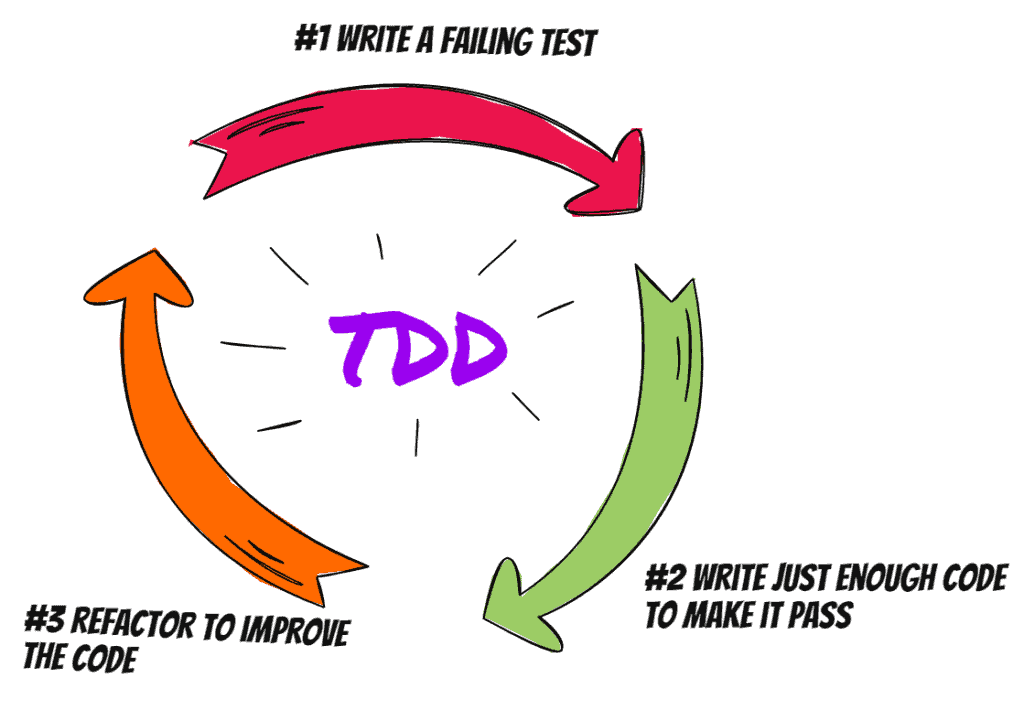Hey, do you know what the goal of any software development project is?
The goal is to produce a high-quality product or service.
Along the way, you can choose two different approaches to achieve high quality: BDD and TDD.
TDD vs BDD: What’s the difference? The goal of behavior driven development (BDD) is to enhance the collaboration between the business and the development team. In contrast, test driven development (TDD) uses a relentless cycle of testing and coding to create a list of specifications for a piece of software.
Both BDD and TDD aim to guide your software development to maintain quality and improve usability, but they differ in their approach.
So, which one should you use? This article will help you understand the pros and cons of each style and how you can apply them to your project.
What is BDD?
Behavior-driven development (BDD) is an agile software development technique that encourages collaboration between the development team, the product owner, and the product’s users.
In BDD methodology, developers, testers, the product owner, and potentially other stakeholders collaborate to develop acceptance criteria and user stories for the application. The collaboration and shared understanding improves the end-user experience and allows for a seamless way to build and test the application.
What are the acceptance criteria? Acceptance criteria are the goals that the new feature should accomplish. It is essential to have these criteria before you start to code.
What are the user stories? User stories are used to identify features or tasks that can be implemented within the project. User stories are typically written in the format of who will use the product/feature, what they will need to do, and what will happen when it is done.
Acceptance criteria and user stories are typically expressed in a Gherkin format. This format has the following structure:
- Given
- When
- Then
One example of an acceptance test:
- Given a user logged in the system
- When the user adds the item to the shopping cart
- Then the shopping cart contains the selected item
BDD is based on test-driven development. It enables both technical and non-technical stakeholders to feel confident about the features the team is building.
It answers the question: does the code have the correct behavior?
Advantages
Behavior Driven Development (BDD) has several advantages over traditional ways of developing software:
- Increased collaboration of stakeholders
- Tests have a wider reach because of the usage of the non-technical language
- It provides living documentation
- Cost-effective strategy
- Focus is on the perspective of the end-user
Disadvantages
Some disadvantages of BDD are:
- It’s not a silver bullet. Using only BDD is not enough. You need to have integration tests and other forms of automated testing.
- Communication between the development team and other stakeholders can delay the project’s start.
- When a test fails, it’s not easy to pinpoint the class that has a failure.
What is TDD?
TDD stands for test driven development, a unit testing technique for developing software by writing tests before you write production code.

The first part of TDD is creating an automated test for the component that the developer is building. You typically use the same programming language for writing the test code and the production code. After you write a test case that fails because of missing functionality, you need to implement the necessary feature. The second part is to write the minimum amount of code required to pass the test. The final step is to refactor the newly passing test with the most appropriate design the developer wants.
TDD is beneficial because it allows developers to validate their work quickly and cheaply.
It answers the question: is the code correct?
Advantages
The advantages of TDD are:
- Code refactoring with confidence.
- The safety net in place that prevents you from breaking things.
- The tests are living technical documentation.
- It forces you to think about what your code needs to do before you write it.
- It improves the system design.
- Increased code coverage.
Disadvantages
The TDD also has some downsides:
- It doesn’t work so well with legacy code.
- The developers need to get used to the process.
- It can be time-consuming.
What is the difference between TDD and BDD?
In software development, there are multiple ways of doing the same thing. One such example is test-driven development (TDD) and behavior-driven development (BDD). Both of these methods have advantages and disadvantages. For example, TDD focuses on the technical aspects of programming, while BDD focuses on the product’s quality and how the end-users will use it.
TDD is a software development process. BDD is a team process.
Let’s explore the differences.
Differences
Test-driven development (TDD) and behavior-driven development (BDD) are two similar processes that focus on the quality of your code. They both involve writing code in small increments to test if the code works.
The differences are:
- Focus: TDD test focuses on testing for functionality, while the BDD test has a broader focus, including testing for design or domain logic.
- Writer: In TDD, the developer writes the test. In BDD, the whole team works together to write the test cases.
- Documentation style: In TDD, unit tests serve as technical documentation. Only developers can read and understand the tests. In BDD, the tests are written in non-technical language. The desired behavior of the application is described in human-readable sentences. Anyone can read and understand them.
- Scope: TDD typically covers a minor feature with a single unit test. BDD covers a single behavior with one test. One behavior might include several parts working together.
- Ease of debugging: With TDD, a failing test pinpoints to the code that has an issue. In BDD, it is not straightforward to identify the root cause.
- Team involvement: In TDD, developers write and maintain the tests. In BDD, developers, the QA team, the product owner, and end-users write and maintain the tests.
As you can see, there are a lot of differences. So the following question would be: can you combine TDD and BDD in a single project?
Can they work together?
Can TDD and BDD work together? Yes.
While working on a project, you can use BDD to develop and describe a new requirement or a feature. After that, you can use TDD to create all the modules of a feature.
TDD and BDD are beneficial for writing excellent quality code, but they have very different roles in the development process.
BDD focuses on the overall solution and how each piece can affect the project as a whole. It forces developers to think about how the different aspects of the project interact and extends the life of the software as new problems arise. Using BDD, the developer will have to think about the desired functionality of the system, how the system should behave, the edge cases, and expected outputs. Thus, BDD follows a more thought-driven approach.
Test-Driven Development involves taking a small chunk of the overall solution and writing tests to pass. TDD is very action-driven. It forces the developer to create a test that fails, then writes code that passes that test. The final step is refactoring. And then the developer repeats the whole TDD cycle. This way, developers can ensure that their code is working and easily integrate new features and fixes.
It’s worth noting that TDD and BDD bring their benefits and challenges to the development process.
TDD vs BDD: Writing failing test vs writing failing feature test
One final difference to discuss is how the TDD and BDD differ at the start of the process.
TDD methodology focuses on writing a failing test case before functionality is written and then ensuring the test suite passes after you implement the missing functionality. Thus, with TDD, you can quickly achieve high test coverage.
BDD is a broader testing method. The process starts by writing a failing feature test. The failing test indicated that a feature of the application doesn’t exist. It then leads to a developer understanding that a code change is necessary, and the developer implements the code to pass the test. The necessary code might take a couple of TDD cycles to be implemented.
Conclusion
The process you use to write your test cases is essential. You should write your test cases in a manner that enables you to get the results you need.
After reading this article, you should know the benefits of TDD vs BDD and the differences between them. You should also know how to perform both approaches. BDD and TDD are wonderful techniques, but they only work well if the team is ready for them.
Together, these tools enable developers to create robust, scalable applications that are quicker to complete, less expensive to maintain, and more reliable.
FAQ

Which is better: TDD or BDD?
Both the TDD approach and BDD approach can be excellent processes for improving the application code. The choice depends on the context and the team.
Can TDD and BDD work together?
Yes, they can work together. These two approaches are similar in that they both involve writing tests before you write production code. However, the tests cover the different parts of the development process. That’s why they complement each other very well.
Is TDD really worth it?
Yes, TDD (Test Driven Development) is worth it. If you can write the test cases before the code, you will be able to test the functionality before you write it. With test cases, you can see automatically what’s working fine and what is not working fine.
